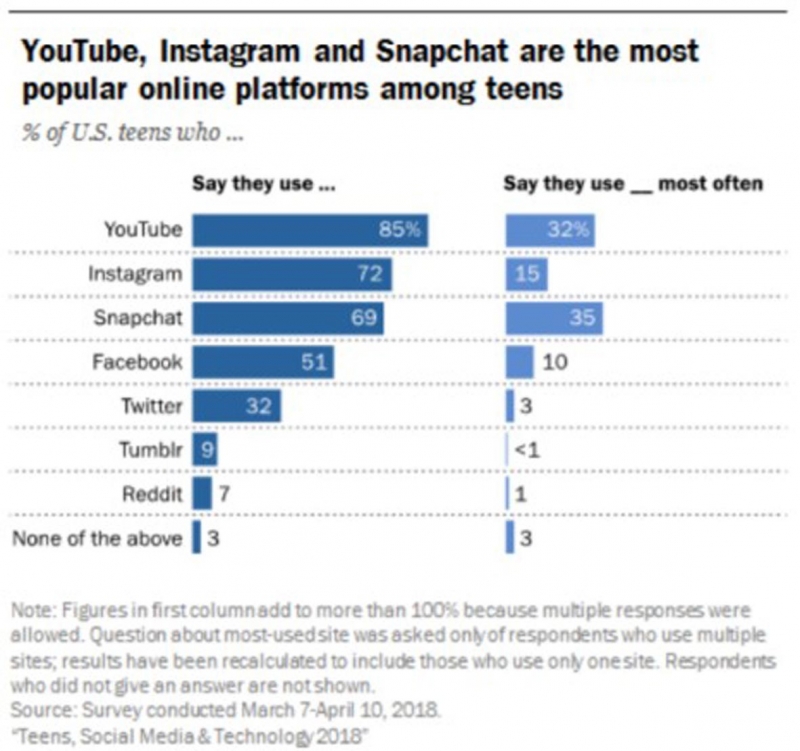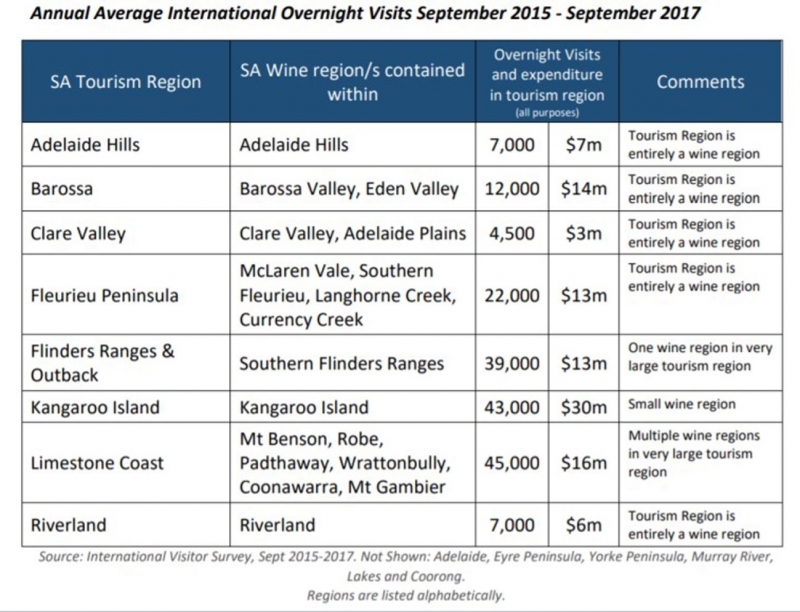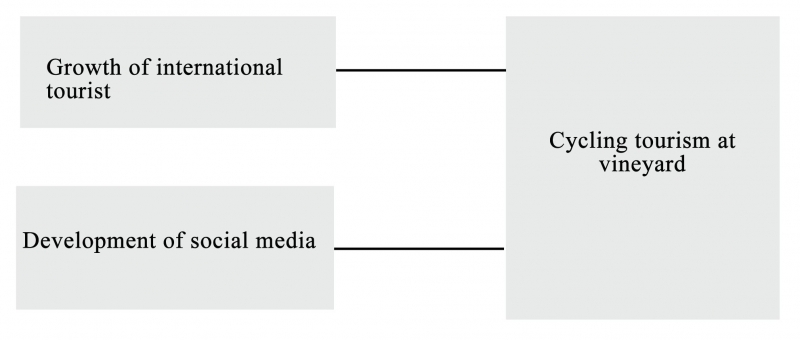Taking the opportunity of publishing this paper, the author Zhensen CHEN (Jexpo) gives the faithful gratitude and highest appreciation to the two co-authors Dr. Markus SCHUCKERT and Dr. Murray MACKENZIE for their insightful instructions and considerate supports during the process of study on wine tourism. In an open-styled teaching mode, the two professors have raised my interest in exploring the insights of wine tourism by their accurately comprehending the subject and extensively quoting the academic literatures.
Special thanks are also given by the author Zhensen CHEN to Dr. Neil LI Hengyun for his smart teaching technique on Research Methodology. The knowledge of research methods with tools of data collection and data analysis enable the author to run the data and draw the conclusion.
Last but not least, the author Zhensen CHEN also thanks the classmates Jacqueline CAO Yu and Francis HUI Shu Tam for their encouragements during the study on wine tourism and composing of this article.
Introduction
Wine tourism towards the vineyard and winery brings a different experience to tourists which contains sightseeing activities indoor and outdoor, as well as drinking and shopping wines in a wide variety. As a new business, wine tourism requires some efforts in marketing to promote in order to attract the global tourists, particularly the young generation. Academic researches have been done to study the impact from digital marketing to the performance of tourism in wine region, as digital marketing plays an important role in modern business. But seldom research has been done on the how the development of social media motivates the tourism activity at the vineyard in the new world and the old world. So this is the gap for this article to research. In order to further the understanding of impact from the development of social media to the flourishing of wine tourism activity, a wine region named Barossa in Australia and an activity of cycling tourism at the vineyard were selected as the sample destination and activity respectively for academic study.
Literature review
Wine tourism and cycling tour
Since wine tourism is getting popular, it becomes a new pillar of national economics for many areas, like Napa Valley of United States. Cycling tour, as one of the activities and experiences at the vineyard, captures people’s attentions in the advertisement of wine tourism of a destination. Managing Director of the Wine Trail, Stephen Dallyn has pointed out that cycling itinerary to the wine region augments guests’ holiday experience1. Cycling is also listed as the top-3 sporting activities with golf and hiking in the strategy plan of wine region Niagara-on-the-lake2. Occasion appears not only in the Old World, wine and other attractions are also combined into a product portfolio of tourism in Saale-Unstrut Region of Germany; in this product, cycling and other sightseeing to culture points with interest have boosted the local wine tourism3. At the top-level vocation tourism development at wine region, activities like cycling, riding, walking, swimming and squash, etc. are listed to be the active attractions for wine region in west Australia4. In this regard, who will be the major customer of cycling tour at wine region? For a hot destination in worldwide like Australia, are international tourists the major customers of cycling tour at their vineyards? So hereby we come to the first hypothesis:
Hypothesis 1: Growth of international tourist has positive effect on cycling tourism at vineyard
Social media development
Pursuant to the statistics from US market, capitals input to global social advertisement in 2017 reached US$ 32 billion; 66% of corporate used Facebook and Instagram, 62% used Twitter and 56% used Linkedln5. Studies have shown up the social media delivers the memorable tourism experiences narrated by past visitors on social media to strange friends on virtual circles, influencing their intention to visit the destination6. That is also the reason why wineries in United States are very popular to adopt Facebook, Twitter, etc. to engage with current and potential tourists through digital networking7.
Illustration 1: YouTube, Instagram and Snapchat are the most popular online platforms among teens.
Source: Teens, Social Media and Technology 2018 (Anderson, 2018).
Per study among teens, percentage of social media users among smart device users soars in high. Study by scholars from Soroma State University proves that 87% of wineries have increased the sales performance via social media practices with the tourists and consumers8. Due to international tourists use social media to acquire the information and book their trips, will they also know the service and activity of cycling tour at wine region via social media? So here comes the hypothesis 2:
Hypothesis 2: Development of social media has positive effect on cycling tourism at vineyard
Wine region of Barossa
Illustration 2: Map of Barossa Valley.
Source: Lovely Planet (Planet, 2019)
As one of the century-old wine regions, Barossa Valley enjoys a high reputation in wine world. Most of the wine brands in Australia own their renown wineries in Barossa Valley like Penfolds, Wolf Blass, Orlando, etc. Except the success in wine-making and selling, Barossa Valley is also attractive to tourists by its charming landscape with foothills, compared to flatter valley floor vineyards9. Therefore, the uniqueness, professionalism in wine-making, hot comments from KOL of win and a vividly described vocation style integrate with the natural attraction, making Barossa a dream destination for global tourists10. During 2015~17, the average international overnight tourism receipts in South Australia including Barossa are listed in table below:
Illustration 3: Annual Average International Overnight Visits September 2015~September 2017.
Source: International Visitor Survey, Sept 2015~2017, Not Shown: Adelaide, Eyre Peninsula, Yorke Peninsula, Murray River, Lakes and Coorong. Regions are listed alphabetically (Australia, 2018).
In order to diversify the tourism products and provide better experience to tourists, Barossa introduced the activity of cycling tour from 2013, and acquired a steady growth in past several years.
Therefore, based on the above elaboration, a framework for research can be drawn out as below:
Illustration 4: Conceptual framework of research on how the development of social media and growth of international tourists motivate the cycling tourism at vineyard.
Composed by the authors.
Methodology
Introduction and design
In this paper, quantitative research method will be used, which is a process of clarification and definition by statistical tests and tools to work on the subjects for understanding their relevance and reliability11. Based on data from survey, quantitative research is good at summarizing the findings through the procedure of calculation or working on data thus to testify the hypothesis, as well as providing some extra merits e.g. generalizability12.
Data collection
Data of the IV and DV are collected from internet, including the portal websites, journals, books and other publications. First step, data for IV1 - growth of international tourists are collected from Tourism Australia Board who publishes the figure of tourists, including domestic and international, periodically on its website. Second step, data for IV2 - development of social media are collected from Tourism Australia Board as well. As a result of collection, number of international tourists visiting Australia per year and number of fans/followers to the social media account of Tourism Australia Board online can be captured and gather in the table below:
Numbers of international tourists to Australia, international tourism receipt and social media fans/followers to the account of Tourism Australia Board on Facebook, Instagram and Twitter in 2014~2017.
Illustration 5: Numbers of international tourists to Australia, international tourism receipt and social media fans/followers to the account of Tourism Australia Board on Facebook, Instagram and Twitter in 2014~2017.
| Year | International Tourist Number (Person) | International Tourism Receipt ($) | Fans /Followers on Facebook | Fans /Followers on Instagram | Fans /Followers on Twitter | Total Number of Fans /Followers |
| 2014 | 7,100,000 | 3,108,000,000.00 | 6,200,000 | 1,000,000 | 235,0000 | 7,435,000 |
| 2015 | 7,800,000 | 3,660,000,000.00 | 7,100,000 | 2,200,000 | 503,800 | 9,803,800 |
| 2016 | 8,500,000 | 3,910,000,000.00 | 7,900,000 | 2,700,000 | 600,000 | 11,200,000 |
| 2017 | 9,100,000 | 4,250,000,000.00 | 8,850,000 | 3,170,000 | 660,000 | 12,680,000 |
Source: Tourism Australia Board (Board, 2014), (Board, 2015), (Board, 2016), (Board, 2017), numbers recorded by the author.
The third step of data collection is for DV - Cycling tourism at vineyard. With the case study at Barossa Valley, data can be collected from the The Barossa Council who published annual report regularly in past years.
Illustration 6: Numbers of bicycle rent and rental income in the vineyards of Barossa Valley within 2014~2017.
| Year | Number of bicycle rent (pc) | Revenue of bicycle rental ($) |
| 2014 | 30 | 1,000.00 |
| 2015 | 374 | 13,070.00 |
| 2016 | 873 | 30,505.00 |
| 2017 | 884 | 32,460.00 |
Source: The Barossa Council (Council, 2014),(Council, 2015),(Council, 2016),(Council, 2017), numbers recorded by the author.
Data analysis
Method of regression is used in this case, which is the most popular analysis method to identify how variables are influencing internally or externally13.
Findings
The first pair of IV-DV is International Tourist Number - Bicycle Rental
After applying the numbers of these two variables into SPSS system or MicroSoft Excel, the result presents as below:
Figure 7: Regression analysis result
| Regression Statistics | |
| Multiple R | 0.972726951 |
| R Square | 0.946197721 |
| Adjusted R Square | 0.919296581 |
| Standard Error | 4253.143943 |
| Observations | 4 |
| ANOVA | |||||
| Df | SS | MS | F | Significance F | |
| Regression | 1 | 636255252 | 636255252 | 35.17314625 | 0.027273049 |
| Residual | 2 | 36178466.8 | 18089233.4 | ||
| Total | 3 | 672433718.8 |
| Coefficients | Standard Error | t Stat | P-value | |
| Intercept | -117447.7642 | 23148.5596 | -5.07365323 | 0.036720688 |
| Tourist number | 0.016825417 | 0.002837006 | 5.930695259 | 0.027273049 |
Source: SPSS or MicroSoft Excel, results worked out by the author
Result of analysis:
P value = 0.027, less than 0.05; it means the data used are valid for analysis.
R2 value = 0.946, quite high; it means the analysis is reliable.
Coefficient = 0.017, it means every increasing of tourist number by 1 unit will lead to an increasing of bicycle rental by 0.017 unit.
The second pair of IV-DV is Fans on Social Media - Bicycle Rental
Run the regression analysis as above, and the result presents as below:
Figure 8: Regression analysis result
| Regression Statistics | |
| Multiple R | 0.967413312 |
| R Square | 0.935888516 |
| Adjusted R Square | 0.903832775 |
| Standard Error | 4642.775209 |
| Observations | 4 |
| ANOVA | |||||
| df | SS | MS | F | Significance F | |
| Regression | 1 | 629322995.5 | 629322995.5 | 29.19565935 | 0.032586688 |
| Residual | 2 | 43110723.28 | 21555361.64 | ||
| Total | 3 | 672433718.8 |
| Coefficients | Standard Error | t Stat | P-value | |
| Intercept | -47487.70352 | 12569.13151 | -3.778121302 | 0.063460573 |
| Fans on Social Media | 0.006493035 | 0.001201679 | 5.403300782 | 0.032586688 |
Source: SPSS or MicroSoft Excel, results worked out by the author
Result of analysis:
P value = 0.033, less than 0.05; it means the data used are valid for analysis.
R2 value = 0.935, quite high; it means the analysis is reliable.
Coefficient = 0.006, it means every increasing of fans on social media by 1 unit will lead to an increasing of bicycle rental by 0.006 unit.
Through the data collection and analysis run by SPSS or MicroSoft Excel, both IVs, namely the number of international tourists to Australia and number of fans/followers on social media to the account of Tourism Australia Board on Facebook/Instagram/Twitter, have positive effect on the DV, namely the revenue of bicycle rental. The data collected from the sample destination are valid enough to work out the findings and draw the conclusion as below.
Conclusion
Since both the IVs have positive effect on the DV, this means both the two hypothesis are proved to be accepted, that growth of international tourist has positive effect on cycling tourism at vineyard, and development of social media has positive effect on cycling tourism at vineyard. Therefore, the conclusion can be drawn as: the development of social media and growth of international tourists motivate the cycling tourism at vineyard. As a sustainable activity at vineyard, cycling tour is warmly introduced by the vineyard at the wine region, and it’s welcomed by wine tourists as proved above. This will be meaningful for consideration of further expansion to other sustainable activities thus to diversify the service at the vineyard, which will bring more experience to wine tourists and more revenues to the wine region. Furthermore, the study can also be applied to other factors which effecting the sustainable activities at the wine region, internally or externally. In addition, this study can also accumulate the experiences for further study to other wine regions, especially the New World like New Zealand, South Africa, etc. Some new coming articles have been published online which are focusing on Chinese wine regions, named as Third World of Wine. This study also can be a good tool for some trial study to the wine regions in China and other country belonging to the Third World.
Due to the time limit in a tight schedule and budget, data are collected in a small size, covering four years from 2014 to 2017. Since the wine tourism has emerged for dozens of years, and social media has emerged for roughly ten years, the data collected for 4 years is quite limited. Another limit lies in the number of sample - Barossa Wine Region only in this study, which may lead to some bias. One of the big limits lies in shortage of data about major social media used among Chinese, which may also lead to some bias, due to China becomes No. 1 in the world in terms of social media users; another important reason is due to China becomes the major origin of international tourists for Australia in the recent years. Therefore, the behavior of Chinese tourists shall be studied in order to work out the full picture of relationship among the IVs and DV. Further research may be conducted to expand the horizons multiple perspectives e.g. wider timing span from 2010 when the social media appeared until 2018 when relevant data can be collected from the tourism boards and other authorities or wine associations; broader regions in wine world like Napa Valley which is another hot destination for global wine tourists, and also the Old World like Italy or France to provide the comparison with the New World, even the Third World like China; research may also be conducted on other activities e.g. hiking, swimming, etc., even golf which is an newly emerging activity in fond of many millionaires in worldwide. Topics related to golf activity in vineyard may attract broad attentions in the society due to the change of lifestyle especially among the young tourists who eager to experience a brand-new lifestyle and the culture of wine, which can bring a good integration for this group of people in interest.




